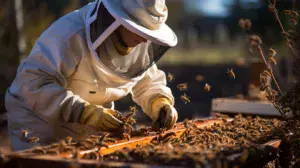A Beginner’s Guide to Splitting Beehives. Hive splitting is exactly what it sounds like—you’re taking one beehive and turning it into two. But why? Well, splitting hives is like hitting the refresh button on your bee colony. It helps manage overcrowding and prevents swarming, which is when bees naturally leave to find more space. Plus, it’s a great way to boost your apiary numbers without forking out more cash for new bees.
So what makes hive splitting so beneficial? Imagine your bees living in cramped conditions—sounds uncomfortable, right? By splitting, you’re giving them more room. This frees up space for the queen to lay more eggs, which means a healthier, happy hive that thrives. When colonies have plenty of room to grow, they’re less stressed and more productive.
Okay, but how do you know when it’s ‘Go Time’ for a split? Timing is key here. Look out for things like overcrowded frames, lots of capped brood, and excess honey. These signals scream that your bees are ready for expansion. Also, if your bees start prepping queen cells, that’s a flashing neon sign saying, ‘Split us now!’ Beekeeping is all about keen observation—get to know your hive’s patterns and quirks.
Tools and Preparations: Getting Ready for the Hive Splitting Process
Before making that hive split, let’s talk tools and prep. Having the right gear is non-negotiable. You’ll need a hive tool, extra hive boxes, frames, a bee brush, and maybe even a queen catcher if things get spicy. This gear keeps things smooth and stress-free for you and your bees.
Taking stock of your hive’s current setup is essential. Check that you’ve got a strong, healthy colony. Your bees need to be buzzing at full strength. Inspect for diseases or pests because you definitely don’t want to spread any issues to the new hives. Consider the laying patterns and the hive’s overall vibe.
Timing for Splitting Beehives isn’t just about the bees. Choosing the right day matters. Look for calm, mild weather—not too windy or hot. Your bees will appreciate it, trust me. Early spring or late fall tends to be the sweet spot for splits, but your local climate will also play a role. Pay attention to what’s happening in nature around you.
Step-by-Step: How to Successfully Splitting Beehives

Splitting a hive isn’t rocket science, but it does ask for some patience and some guts. You’re basically telling a bunch of bees to rearrange their entire life. Start by scouting out that busy hive. Trust me—you’ll want to make sure the hive you’re splitting has plenty of resources and a healthy queen.
Got your perfect hive? Cool, next grab your gear. Suit up, grab your hive tool, and all the boxes you’ll be using. Gently open up the hive and start removing frames, searching for brood, honey, and the queen. Look for a good balance: You want both hives to have enough resources to thrive.
Now comes the fun part: the actual split. Decide how you’ll be dividing up the frames. A classic move is to leave the old queen in the original spot and move half of the brood and resources to the new hive box in a different location. This encourages balance between the two. Remember to brush any extra bees from the frames into the new box to keep those numbers healthy.
After splitting, take care of your new hive. Position it carefully, maybe in a slightly new location to prevent drift—all those worker bees flying back to their old home. Keep an eye on the new queen—or potential queen—in both hives. If you’re feeling fancy, adding a feeder can give them a nice boost, ensuring everyone settles in nicely.
Common Mistakes and Troubleshooting: Navigating Challenges Post-Split
Splitting Beehives done and dusted? Awesome, but there’s a bit more to do. The aftermath of a split can sometimes get a bit rocky, especially for beginners. One of the big mistakes is not having enough bees in one of the hives, leaving it weak and unable to thrive. Balancing the two is key, so don’t stress if you have to adjust a bit right after the split.
Another slip-up to dodge is neglecting the forage situation. Bees need food—throwing them into an empty field won’t cut it. You gotta make sure there’s plenty for them to munch on right away. Sometimes this means adding a feeder just to tide them over until they get their bearings in their new setting.
An easy fix for some stress is ensuring the new queen is accepted. If the bees aren’t thrilled with her, they might start prepping for a replacement. Giving her some time in a queen cage can make all the difference. Let them get to know her scent before releasing her to rule the roost. Keeping emotion out of it helps you fix things faster.
Finally, keep tabs on the general hive health in the weeks following a split. New hives need that extra TLC. Check for signs of disease, keep an eye out for pests, and ensure they’re showing growth signs. Remember, beekeeping is as much instinct as it is science, so go with your gut and what’s buzzing in your plot.

Hi Mats,
Thank you for such an informative and engaging guide on hive splitting! I really appreciate how clearly you’ve broken down the process and provided actionable advice for beginners.
While reading, I found myself curious about how beginners can tell if their colonies are strong enough to split. Are there any specific signs to look for to avoid over-splitting or weakening a hive? Also, how do you balance giving enough resources to both hives while ensuring neither one is left struggling?
Your emphasis on timing and weather conditions really stood out to me. Do you have any tips for beekeepers in regions with unpredictable weather or harsher climates? It seems like timing would be trickier in those situations.
Lastly, I loved your section on common mistakes and troubleshooting. Are there any other surprising challenges you’ve encountered when splitting hives that might not be obvious to beginners?
Thank you again for such a detailed and helpful guide. It’s clear you have a lot of experience and passion for beekeeping, and it really shines through in your writing!
Hi Roopesh!
Thank you for your thoughtful feedback! To determine if a colony is strong enough to split, look for signs like full brood frames, ample honey stores, and high bee population. Balance resources by dividing brood, honey, and worker bees equally while ensuring both hives have enough to thrive. For unpredictable climates, monitor forecasts closely and plan splits during stable weather. I say, beginners should also be prepared for challenges like queen rejection or weak splits and address these proactively.
Your kind words are much appreciated!
/Mats
Great article! A few questions came to mind: How long does it typically take for the new hive to stabilize after a split? Also, is there an ideal number of worker bees to ensure both hives are balanced? Lastly, what’s the best way to handle queenless splits—should a beekeeper always introduce a new queen, or are there situations where the bees will naturally create one? Would love your insights!
Hi Herman!
Thank you for your questions! After a hive split, stabilization usually takes 1-2 weeks as bees adjust. Aim to balance worker bees evenly, with enough in both hives to maintain brood and forage effectively. For queenless splits, introducing a new queen ensures quicker stability, but in strong colonies with resources, bees can successfully raise a queen naturally.
/Mats
My cousin is a beekeeper, so I’m pretty knowledgeable about the subject. Splitting hives is such a fascinating process, and it’s amazing how it can help manage hive populations and prevent swarms. One question I have is about the timing of splits — how do you determine the perfect time to split a hive without risking the health of the colony? Is it better to base it solely on hive population, or should you also consider factors like time of year and local climate? I’m also interested in introducing a new queen into a split. If a beekeeper decides not to allow the colony to breed their own queen, what’s the best approach to ensuring that the new queen is accepted? Are there any specific strategies to reduce the chances of rejection? Finally, for someone who only manages a few hives, how often would you recommend splitting to maintain healthy colonies without overusing resources?
Hi Slavisa!
Thank you for your comments and questions!
Timing hive splits involves balancing colony health, population, and external conditions. Ideally, split during spring or early summer when resources are abundant, and the hive is thriving. Hive population is key, but also consider local climate and nectar flow for optimal success.
To introduce a new queen, use a slow-release method, such as a queen cage, allowing workers to adjust to her pheromones. Feeding the colony during the transition can further reduce rejection risks.
I would say, for small-scale beekeepers, splitting once every 1-2 years is often sufficient to manage hive health and prevent overcrowding without straining resources.
/Mats
I learned something new today as I thought you simply left bee hives alone to thrive and only harvested the honey from time to time. I didn’t know that they could be split and that there is even a good time to do it.
I just would love to know how you would produce a second queen bee. Would it be the biggest bee in the colony that would automatically take over the role?
Hi Michel!
Thank you for your question! When splitting a hive, bees naturally raise a new queen by selecting a fertilized egg and feeding it royal jelly. This specialized diet triggers the development of a queen. It’s not about size but the larva’s diet and treatment by the worker bees.
/Mats